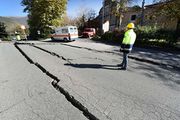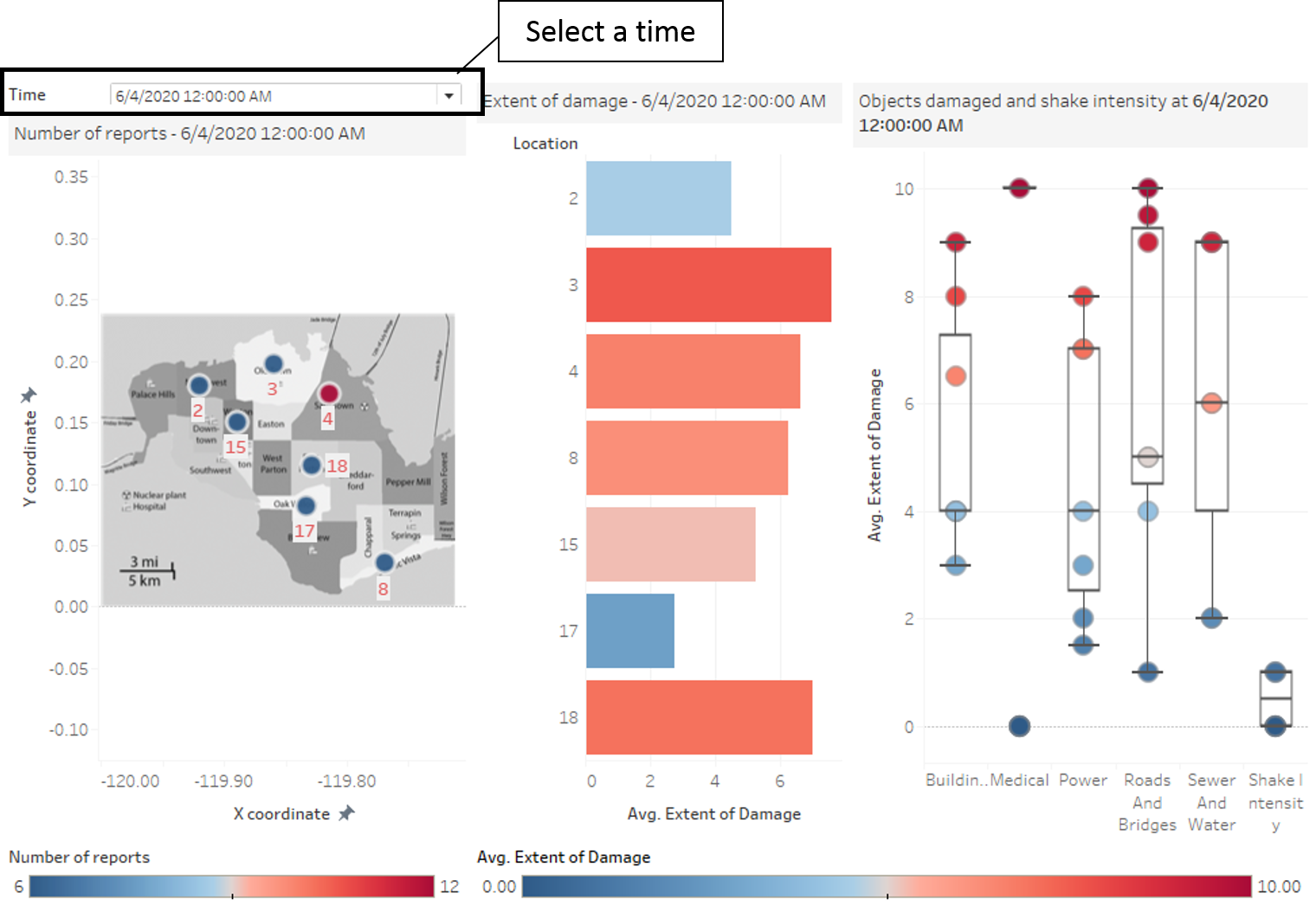 VAST Challenge 2019 MC1: Crowdsourcing for Situational Awareness
VAST Challenge 2019 MC1: Crowdsourcing for Situational Awareness
Task 1: Analyse how neighborhoods should be prioritsed for response and find out which parts of the city are hardest hit
Emergency responders will base their initial response on the earthquake shake map. Use visual analytics to determine how their response should change based on damage reports from citizens on the ground. How would you prioritize neighborhoods for response? Which parts of the city are hardest hit? Limit your response to 1000 words and 10 images.
| Insights |
Visualization |
| 1.1 Analysis of damage reports by time and average damage on location
The damage reports are analysed at the time they are received. When reports are received, cities which have the the highest average damage will be looked into. The number of reports is indicated by the size of the circle marked on the map.
|
 |
| 1.2 Analysis of damage reports by average damage of objects
When a location is selected based on the average damage, the average damage of each object can then be seen in comparison to other location based on the point in time. For instance, location 3 is selected, and on the left, the damage on each item can be seen relative to other locations. As such, the respondents are able to see what they should prioritise for this location and if other location has worse damage than the current location. Looking at the breakdown of damage on location 3, the damage on sewer and water is not the highest at this point and there is another location (Location 4) there has worse damage on sewer and water facilities. Given that all these repair and respondents are from different departments of St. Himark, decisions on which department to send can also be made.
|
|
1.3 Analysis of Location with the hardest hit
In this analysis, shake intensity is removed as we are focusing on the damage done to the cities. Based on the average damage of all the damage reports, we can see that location 7 has the highest average damage. However when looked in location 7, the root cause of the high average damage comes from the damage on the power. On the other hand, looking at location 8, which has the next highest damage, damages are inflicted on almost all infrastructures and facilities. Although location 7 has highest damaged on its power, the situation is probably not as critical as locations with damages on its infrastructures and facilities which can results in loss of lives. |
|
3.Extended campers
The day for extended campers started a bit later than day campers, from 6am onwards. The time of exit for them also spread over a longer time range (Fig 3.1). Unlike the day campers, they tend to settle down at the more secluded camp sites like camp 5 and camp 8, to enjoy a quiet night of sleep (Fig 3.2). |
|
4.Rangers
The day of rangers started from the ranger base and ends there with their first shift started at 6am and the last shift started at 17pm (Fig 4.2). They travelled by long but fixed paths, the reason could be that they are working on routine shifts (Fig 4.1). There are two typical paths adopted by the rangers, the maintenance path and the patrolling path. The maintenance path passed through various restricted gates, which was normally started at 6am,11am and 14pm. The patrolling path covered the entire reserve, started at regular hour intervals. |
|
5.Service Trucks
The service trucks are axle-4 and above heavy vehicles which moved around the reserve throughout the day. They seemed to be visiting the reserve at fixed hours daily – majority of them reported to the “most scenic path” at 6am and 15-16pm daily (path 1 in Fig 5) while the others revolved along entrance 1->generalgate7->entrance 3 at 10am & 14pm daily. These are probably service or supplies trucks transporting goods in and out of the reserve. |
|
6.Sightseeing coaches
The sightseeing coaches brought guests to the reserves throughout the day, without entering into the camp sites. Majority of the visitors were brought to the “most scenic path” from different entrances (path 1 in Fig 6) while the rest were dropped along the camping path (path 2 in Fig 6) which connected camps 3,4,5. Unlike the truck drivers, the sightseeing coaches used entrance 3 instead. |
|
Task 2: Use visual analytics to show uncertainty in the data, compare the reliability of neighborhood reports and find out which neighborhoods are providing reliable reports.
Use visual analytics to show uncertainty in the data. Compare the reliability of neighborhood reports. Which neighborhoods are providing reliable reports? Provide a rationale for your response. Limit your response to 1000 words and 10 images.
Task 3: Examine how the conditions, uncertainty in and key changes have changed over time
How do conditions change over time? How does uncertainty in change over time? Describe the key changes you see. Limit your response to 500 words and 8 images.


